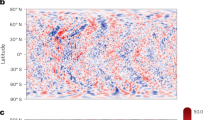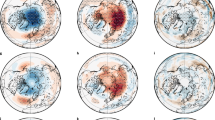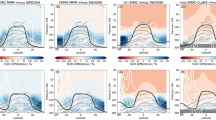Abstract
Since the seasonal and spatial distribution of ozone on Mars was detected1 by the ultraviolet spectrometer onboard the spacecraft Mariner 7, our understanding has evolved considerably thanks to parallel efforts in observations and modelling2,3,4,5,6,7. At low-to-mid latitudes, martian ozone is distributed vertically in two main layers, a near-surface layer and a layer at an altitude between 30 and 60 km (ref. 5). Here we report evidence from the SPICAM UV spectrometer onboard the Mars Express orbiter for the existence of a previously overlooked ozone layer that emerges in the southern polar night at 40–60 km in altitude, with no counterpart observed at the north pole. Comparisons with global climate simulations for Mars indicate that this layer forms as a result of the large-scale transport of oxygen-rich air from sunlit latitudes to the poles, where the oxygen atoms recombine to form ozone during the polar night. However, transport-driven ozone formation is counteracted in our simulations by the destruction of ozone by reactions with hydrogen radicals, whose concentrations vary seasonally on Mars, reflecting seasonal variations of water vapour. We conclude that the observed dichotomy between the ozone layers of the two poles, with a significantly richer layer in the southern hemisphere, can be explained by the interplay of these mechanisms.
This is a preview of subscription content, access via your institution
Access options
Subscribe to this journal
Receive 12 print issues and online access
$259.00 per year
only $21.58 per issue
Buy this article
- Purchase on Springer Link
- Instant access to full article PDF
Prices may be subject to local taxes which are calculated during checkout




Similar content being viewed by others
References
Barth, C. A. & Hord, C. W. Mariner ultraviolet spectrometer: Topography and polar cap. Science 173, 197–201 (1971).
Clancy, R. T., Wolff, M. J. & James, P. B. Minimal aerosol loading and global increases in atmospheric ozone during the 1996–1997 Martian northern spring season. Icarus 138, 49–63 (1999).
Fast, K. et al. Ozone abundance on Mars from infrared heterodyne spectra. I: Acquisition, retrieval, and anticorrelation with water vapor. Icarus 183, 396–402 (2006).
Perrier, S. et al. Global distribution of total ozone on Mars from SPICAM/MEX UV measurements. J. Geophys. Res. 111, E09S06 (2006).
Lebonnois, S. et al. Vertical distribution of ozone on Mars as measured by SPICAM/Mars Express using stellar occultations. J. Geophys. Res. 111, E09S05 (2006).
Lefèvre, F., Lebonnois, S., Montmessin, F. & Forget, F. Three-dimensional modeling of ozone on Mars. J. Geophys. Res. 109, E07004 (2004).
Krasnopolsky, V.A. Photochemistry of the martian atmosphere: Seasonal, latitudinal, and diurnal variations. Icarus 185, 153–170 (2006).
Clancy, R. T. et al. Extensive MRO CRISM observations of 1.27 mm O2 airglow in Mars polar night and their comparison to MRO MCS temperature profiles and LMD GCM simulations. J. Geophys. Res. 117, E00J10 (2012).
Bertaux, J-L., Gondet, B., Lefévre, F., Bibring, J-P. & Montmessin, F. First detection of O2 1.27 mm nightglow emission at Mars with OMEGA/MEX and comparison with general circulation model predictions. J. Geophys. Res. 117, E00J04 (2012).
Fedorova, A. et al. The O2 nightglow in the Martian atmosphere by SPICAM onboard of Mars-Express. Icarus 219, 596–608 (2012).
Richardson, M. I. & Wilson, R. J. A topographically forced asymmetry in the Martian circulation and climate. Nature 416, 298–301 (2002a).
Clancy, R. T. et al. Water vapor saturation at low altitudes around Mars aphelion: A key to Mars climate? Icarus 122, 36–62 (1996).
Richardson, M. I. & Wilson, R. J. Investigation of the nature and stability of the Martian seasonal water cycle with a general circulation model. J. Geophys. Res. 107, 5031 (2002).
Montmessin, F., Forget, F., Rannou, P., Cabane, M. & Haberle, R. M. Origin and role of water ice clouds in the Martian water cycle as inferred from a general circulation model. J. Geophys. Res. 109, E10004 (2004).
Montmessin, F. et al. A layer of ozone detected in the nightside upper atmosphere of Venus. Icarus 216, 82–85 (2011).
Piccioni, G. et al. Near-IR oxygen nightglow observed by VIRTIS in the Venus upper atmosphere. J. Geophys. Res. 114, E00B38 (2009).
Bertaux, J-L. et al. SPICAM on Mars Express: Observing modes and overview of UV spectrometer data and scientific results. J. Geophys. Res. 111, E10S90 (2006).
Quémerais, E. et al. Stellar occultations observed by SPICAM on Mars Express. J. Geophys. Res. 111, E09S04 (2006).
Montmessin, F. et al. Stellar occultations at UV wavelengths by the SPICAM instrument: Retrieval and analysis of Martian haze profiles. J. Geophys. Res. 111, E09S09 (2006).
Lefèvre, F. et al. Heterogeneous chemistry in the atmosphere of Mars. Nature 454, 971–975 (2008).
Acknowledgements
F.M. sincerely thanks CNES for funding the SPICAM instrument in France, and UVSQ for helping to support SPICAM operation planning activity.
Author information
Authors and Affiliations
Contributions
F.M. developed the retrieval model of the SPICAM ozone profiles and is the Principal Investigator of the SPICAM instrument on-board Mars Express. F.L. developed the three-dimensional photochemistry model used for interpretation and participated in the analysis of the data.
Corresponding author
Ethics declarations
Competing interests
The authors declare no competing financial interests.
Supplementary information
Supplementary Information
Supplementary Information (PDF 638 kb)
Rights and permissions
About this article
Cite this article
Montmessin, F., Lefèvre, F. Transport-driven formation of a polar ozone layer on Mars. Nature Geosci 6, 930–933 (2013). https://doi.org/10.1038/ngeo1957
Received:
Accepted:
Published:
Issue Date:
DOI: https://doi.org/10.1038/ngeo1957
This article is cited by
-
Observation of the Mars O2 visible nightglow by the NOMAD spectrometer onboard the Trace Gas Orbiter
Nature Astronomy (2023)
-
Observations and Modeling of Martian Auroras
Space Science Reviews (2022)
-
Retrieval of Martian ozone and dust from SPICAM spectrometer for MY27–MY28
Journal of Earth System Science (2019)
-
Investigations of the Mars Upper Atmosphere with ExoMars Trace Gas Orbiter
Space Science Reviews (2018)
-
NOMAD, an Integrated Suite of Three Spectrometers for the ExoMars Trace Gas Mission: Technical Description, Science Objectives and Expected Performance
Space Science Reviews (2018)



